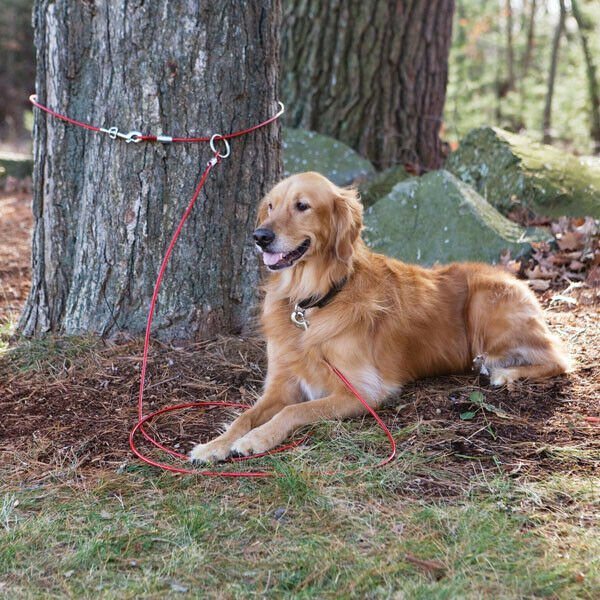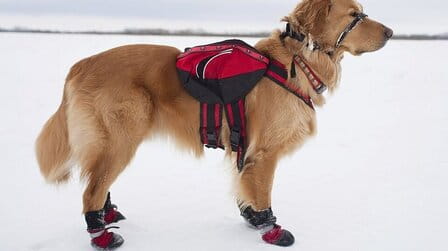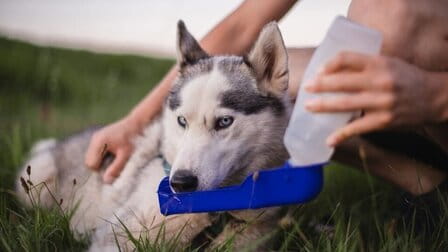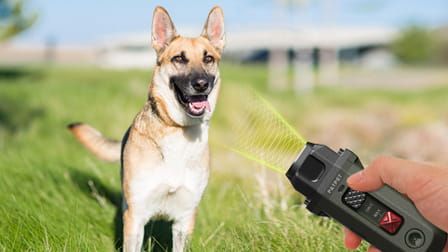Tethering our dogs with a tie-out cable is controversial with different mindsets and for or against opinions. Many people support tethering your dogs with cables while others, including big organizations, say that tethering dogs is not only harmful to the dogs but also increases the risk of danger for both dogs and owners. In this article, we will explain further and clarify our "For" viewpoint on this problem.
1. What Is A Dog Tie-Out Cable? How Does It Work?

A tie-out cable is simply a long piece of cable made out of several material kinds such as fiber or plastic. Their major purpose is to prevent your dogs from running wild under no supervision or owner's appearance in the surrounding environment. A cable can be combined with a dog harness or collar when in use.
2. The Controversial Debate About Tethering Dogs With Tie-Out Cables
Why do many people go against tethering dogs with tie-out cables?

We have acknowledged the perspective of why we should not tether dogs with cables. The first reason for this "Against" viewpoint is humanity. Dogs should not be tied up when they stay outside. Although this explanation in several cases is not convincing enough, it is emphasized in specific situations. The situations include owners leaving their dogs under harsh weather conditions.
The second reason for the "Against" opinion is the safety of dogs. They believe that tethering dogs outside can lead them to confront certain serious risks. The risk is facing another dog, which can cause attacks or injuries. Also, leaving your dogs outside for too long under harsh weather conditions can create health hazards in dogs. Moreover, their necks have to stand pressure for either long or short periods. This appears quite convincing. However, we believe it only emphasizes the negative sides without looking at the bright ones.
The last reason why many people do not support dog cables is their fear of cables posing a threat to humans. Although this does not count much, the threat does exist. Some aggressive dogs with long tie-out cables would act in a violent way as they are most likely to bite passengers. The passengers bitten here are often unattentive of the dog's state or the distance between them and the dog.

There are several states in the US claiming it is illegal to chain dogs outside as a full-time lifestyle. They have proven that this full-time tethering causes the dog to be antisocial and aggressive, posing safety threats for households, especially children.
Why do we say yes to tie-out cables?

Whilst many people go against the action of using cables for dogs, we still give a yes. In our case, the tie-out cable is not used 24/7 per day, but in certain periods or even days.
Cables are normally used in dog training, mostly applied for armed dogs or large and aggressive breeds. The cable when used aims at creating the patience and calming traits for dogs. Since it is the case, tethering your dogs is not animal abuse. The training time only lasts for 1 to 3 hours per day, with supervision and under proper weather conditions. In several pieces of training, tie-out cables are the deciding factors for success.
Our third reason goes to the dog's and owner's safety. For instance, your yard is yet to be fenced, leading to your dog running wild without protection or observation of owners. The worst case is that your dog may get lost or get into a fight with another dog but you cannot find out where he or she has reached. A cable under this circumstance will help to keep the dog in your sight.

Let's take another case as a reference. Your new adopted dog is aggressive and ready to be violent against anyone, including you. It is time you had several control methods to keep yourself and the family safe before you can finish training the dog. Tethering dogs is not necessary outdoors as people still assume it. It can be inside your house, guaranteeing a safe zone.
To sum up, we still consider using a tie-out cable is not as harmful as some individuals would claim it to be. Using cables for proper purposes, not abuse is a should-take action.
3. How To Use Tie-Out Cables For Our Dogs?

Along these lines, we will guide you on how to use a tie-out cable. You would easily catch sight of a leash or rope. A tie-out often has a length of 2 to 3 feet and can be adjusted for the most suitable usage.
The first step when using the cable is letting your puppy get used to the cable. When you suddenly tie down your dog with a cable, it can be overwhelming for the dog. From such a shock, your dog may have an unpleasant impression about the cable, then develop the fear of tie-out cables.
After purchasing a cable, bring it near your dog and let him or her smell it. Dogs read information about their surroundings through their noses. They smell and remember the items or people approached. The case is the same for tie-out cables. After a few minutes of getting acquainted with each other, start to treat your dog for a more calming state and to let them know the cable does no harm. It is best to train your dog to be patient before using a cable. Then slowly tether your dog with the cable. Keep in mind that you must not let the cable become intense and leave stress on your dog's neck. Continue the small treats to calm your dog down.

You will not tie your dog for a long period in the beginning but short ones first. It is best to go from 10 minutes per day for the first 4 or 5 days. Then increase the time of tethering the dog. You can go from 3 to 5 minutes to 10 minutes, then 15 or 20 minutes per day. Remember that this process must be taken slow to let your dog get used to the cable and do not associate the cable with anger or unpleasant experience.
The whole purpose of the cable then is to help train your dog's patience and become more obedient. After each tethering, treat your dog with his or her favorite food. Through this, your dog will understand that all he or she has to do is patiently wait until you come back to take off the cable. They will slowly associate the cable with their rest time instead of being chained up in a negative way.
Training dogs, whether for duties or simply better behaviors at home, need a long period. The time is necessary to form your dog's habits and characteristics. It should not occur too fast, too sudden, and too aggressive. Allow your dog to have time and space to gradually understand what they should or should not. Cable training can be applied for numerous activities, including potty training, no begging at the table, or being patient.
Conclusion
Here are our last thoughts on the topic of using tie-out cables. Many people have placed a prejudice on the dog cables, though it should not have turned out that way. It is undeniable that some owners abused their dogs, and the image of dogs being tied down is discouraged in numerous countries these days.
However, the cable in the first place was to serve as a supporter for dog owners or trainers. Lately, the cable is still applied for training purpose, and we consider it as the true aim of any device - to help dog parents and dogs themselves.













